#also i love love love future mimicking other AIs as a concept just
Text
looking at last year’s SAYER doodles so you can have this absolutely-not-canon interaction of FUTURE mocking SPEAKER on the house tonight

#SAYER podcast#SPEAKER AI#FUTURE AI#peak sibling behavior#SAYER fanart#these feel old ish and theres stuff to be fixed but IM NOT plugging my tablet so#take it or leave it#also i love love love future mimicking other AIs as a concept just#its so good#also rb ok#my art
76 notes
·
View notes
Text
May 9, 2021: A.I. Artificial Intelligence (2001) (Recap: Part One)
Welcome to the future.

At this point, we’ve mostly looked at the past, present, or the near-future (as in, the next ten years, if that). Additionally, we’ve looked either at nonexistent technology in a contemporary setting, or an extension of existing technology taken to a logical next step. But no more. No more realism, no more real-world rules, and nothing that we’re even close to in this reality.
Well...mostly.
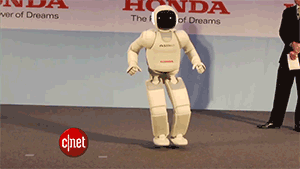
That’s genuinely impressive, not gonna lie. Anyway, yeah, from here forwards (for a bit), we’ll be looking at the future and futuristic technology. Now, there are a couple of ways in which these films tend to go. The first big way that we tend to represent the future in film is the same way we always have: flying cars, futuristic technology, smart houses, and robots.
Now, there are countless examples of this future, and it always changes a bit depending on the present. Which, yeah, makes sense. After all, what I’m doing right now, at this moment, would’ve been seen by many people as a massive technological achievement, even around the time that I was born. Which, yes, I’m old, deal with it (because I can’t). Anyway, the way that this begins is with the first major filmed view of a seemingly idyllic future: Fritz Lang’s 1927 film Metropolis.
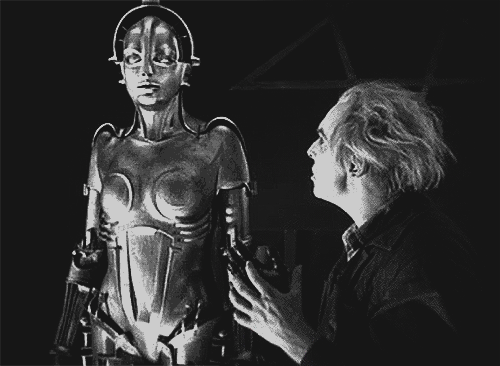
The overly mechanized (and politically dystopic) society seen in this film, as well as the visuals and technology, would inform our ideas of the future throughout the next century. Multiple themes and common objects reoccur throughout futuristic fiction. You know the stuff I’m talking about. Flying cars, automatic food machines, robotic assistants, video watches, holograms, jetpacks, so on and so forth.
But here’s the thing about the future. It’s always ahead of us, and eventually...well, we’ve gotten to most of those things to some degree. Either they already exist...
youtube

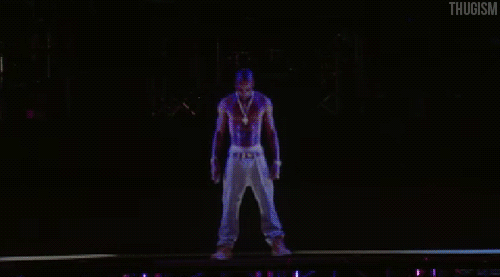
...or is currently being developed.


Well, one of them we’re still working on. And the development of more advanced AI is something we have yet to perfect, or even fully develop. However, the development of A.I. (and the consequences of that technology) are ALL OVER science fiction. Sometimes, they’re merely used for flavor to help establish the futuristic setting.

Sometimes, they’re characters with their own agency and conflicts, which may or may not define the plot. In these cases, they’re often simply there to back up the main human characters, and help with their development, and sometimes their own. You know, manic pixie dream robots.
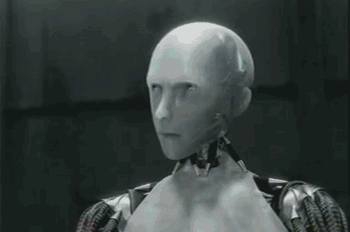
And then, possibly most often, they’re the abject villains of the piece. they can be mysterious alien technology, like in The Day the Earth Stood Still, or a man-made danger that turns on the race that created and/or abused it.



But then, on occasion, an A.I. is given the chance to develop as a character, without being used to define the development of a human character. Sometimes, the question of what life truly means is raised through these characters, and we become attached to them outside of any other character. This isn’t nearly as common as the others, but it’s definitely not unheard of.



And for the record...things don’t often go well for those AIs. But still, some of those characters have quite a lasting impact. So, there’s quite a lot of potential for this type of character, from a dramatic standpoint. And that potential leads us to the guy who made this.
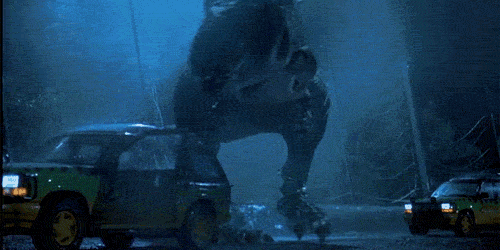
I WILL MAKE A JURASSIC PARK REFERENCE AS OFTEN AS POSSIBLE
Steven Spielberg gives us today’s entry, and this director of a classic science fiction story about science gone awry teamed up with the director of a science fiction film where an artificial intelligence went awry. You know, this thing.

I didn’t forget about HAL. And I won’t forget about him later, either.
Director Stanley Kubrick is pretty well-know for his mind-bending films, especially The Shining and 2001: A Space Odyssey. But he also worked with Spielberg on this film before his death in 1999, as this was one of his dream projects for many years, and the two directors were well-known friends.
And so, eventually, Spielberg was given the reins from Kubrick, and results were...mixed. It’s funny, because I’ve never actually seen this movie, but I remember it through its surprisingly widespread ad campaign. I used to go to NYC as a kid a lot, and there was a massive building-side plastered with the iconic logo of this movie. So, I’ve been hovering around this movie for a long time. Enough navel-gazing!
SPOILERS AHEAD!!!
Recap (Part One)
It is, unsurprisingly, the future. A marrator informs us that climate change has caused the ice caps to melt, and global flooding drowns several countries. You could say that it’s a...Waterworld.

I genuinely considered watching that movie at some point, and then I decided I liked myself to much to watch 2 hours of Kevin Costner’s emotionless acting. Granted, it’s not much better now, listening to the emotionless acting of...
Professor Allen Hobby (William Hurt) is a straight-up sociopath. OK, technically, he’s a robotics engineer, but dude’s making a speech, right? He talks about how far robots have come, dissing my boi Deep Blue in the process, and notes that pain-memory response can also be demonstrated by robots. He proves this by stabbing a woman in his audience, like RIGHT through the hand. Jesus, man! Why the hell would you do that?

Oh. Holy shit, I got fooled. Advanced technology indeed. But OK, so Sheila’s a robot, and a very advanced one...to us. But Hobby wants more, and proposes to his workers to make a robot that can really TRULY love. And through love may come a true subconscious, which means making a robot that can dream. And what better robot to make than a robot child? After all, all child conception requires a license in this futuristic world, so many childless couples are yearning for a child.

Which is why, twenty months later, the first robot child is offered to Henry and Monica Swinton (Sam Robards and Frances O’Connor), a couple...with a child. Um. Guys. You JUST SAID that there are legit childless couples who need a child, and those people would be best suited to love that robot child back (a VERY GOOD question raised by one of Hobby’s subordinates). So why give it to a couple whose son is still alive? Yeah, he’s got a rare disease that they don’t have a cure for yet, and is currently in cryostasis, BUT THEY HAVE A KID! Surely, that’s going to be a potential emotional conflict! And what if the kid wakes up or some shit? This is a TERRIBLE goddamn idea. Think this shit through, guys.
And yet...

This is David (Haley Joel Osment), Cybertronics’ first child robot, brought home by Henry to essentially replace their son. Which is AMAZINGLY FUCKING TONE-DEAF AND INSANE, GODDAMN. That’s extraordinarily messed up. And, for the record, I totally get what Spielberg’s going for, but Jesus Christ, man. This was a terrible way to go about this. And it gets fucking WORSE.
See, Henry (who actually works for Cybertronics) tells Monica that, once they sign the papers and complete the updates, David will imprint on them and see him as their true parents, loving them unconditionally. Which...yeah, fuck, that’s an entire DUMP TRUCK of ethics issues right there. And, while we’re at it, David is...creepy as shit. I mean it, dude, Haley Joel Osment is a VERY good child actor, but he’s laying on the creepy robot child thing THICK. And yeah, this is BEFORE he imprints on them. Jesus fuck, man, there’s a scene where the still uncomfortable Monica is outside of a glass door, and he looks back at her THROUGH THE DOOR like a goddamn SERIAL KILLER.

And I gotta tell ya, dude does not lay off that creepy-ass dial one iota. And for that matter, the music by John Williams ISN’T FUCKING HELPING. LISTEN to this shit, and imagine a robot child that you don’t know wandering around your house. It’s amazingly fucking creepy.

AND IT JUST. KEEPS. GETTING. WORSE. There’s a scene where they’re all at dinner, right, and David’s just staring at them as they eat, mimicking their actions. After all, he’s a robot, he can’t actually eat or drink anything because of his internal working. And then, out of FUCKING NOWHERE, he starts laughing like the FUCKING JOKER, and it scares the EVER-LOVING SHIT OUT OF ME. And somehow, they laugh alongside him, in the never-ending Stockholm syndrome that is this movie! And as soon as its over, he just STOPS laughing, spontaneously. Fuck me, man, I’m tempted to stop watching here and now, and I’m only TWENTY MINUTES IN! I need a fucking break.
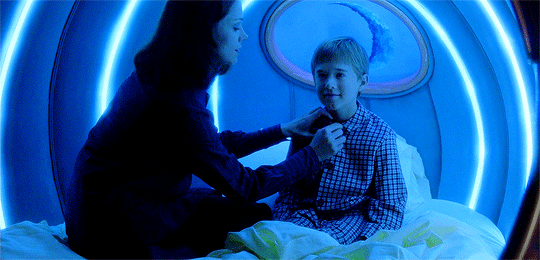
And after that...OF COURSE she decides to activate his imprinting protocols to make him, let me remind you, LOVE HIM FOREVER! She reads out a series of words, and after “FREIGHT CAR”, he knows his mission is to kill the Prime Minister of Sokovia. But first, he’ll settle down and love Monica unconditionally (again, FOREVER), calling her Mommy and making me shit my pants in fear. IT WASN’T ME, IT WAS FUCKING DAVID
Oh, and by the way, isn’t it kinda shitty to do that without Henry being involved AT ALL? Like, cool, he has unconditional maternal love, but Henry wasn’t a part of that conditioning at all! And he still refers to him as “Henry” instead of Dad! However, Henry definitely doesn’t care about that, because he still sees David as only a robot. Hey, guys, maybe using these two as your first experiment with a robot child WAS A TERRIBLE FUCKING IDEA, YOU IDIOTS! No wonder William Hurt was cast as Thunderbolt Ross in the MCU. Already shown he can play a character with shitty ideas before.
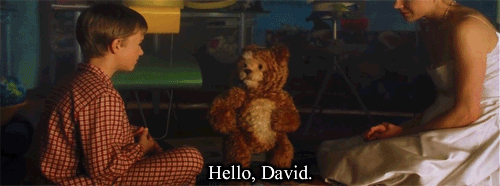
Anyway, after this terrible series of events, David prevents the parents from leaving one night due to his childlike antics. When Monica goes to comfort him, he asks how long she’ll live, and tells her that he hope she never dies, a COMPLETELY NORMAL THING TO SAY. Look, I get that he’s a robot, but only a goddamn emotionless sociopath would program emotional responses like this into a robot. Which, given what we’ve seen of Hobby, makes sense.
In response, she gives him Teddy (Jack Angel), a technologically advanced teddy bear with sentience, a personality, and the voice of Astrotrain from The Transformers TV series. Because, yes, I am THAT MUCH of a goddamn nerd.

Soon after, the house gets a phone call, which David receives...literally. He takes the phone and allows it to speak through him. It turns out that, shock beyond shocks, THEIR SON IS CURED! Yeah, fuck. Maybe giving David to a family with a STILL LIVING SON is a fucking ABSOLUTELY TERRIBLE IDEA, for about a thousand reasons.
And, fucking understandably, Martin Swinton (Jake Thomas) is a little upset to find out that he’s essentially been replaced by a robot kid. Although, to be fair, he’s also kind of a dick to David, holding his humanity over him and treating him as a toy that he attempts to manipulate and bully. My Lord, this is a massively stupid idea. And Martin immediately shows his dickishness by asking his mother to read Carlo Collodi’s The Adventures of Pinocchio to them. Which is meant to be a punishment for Pinocchio. However, of course, David loves it.

Still, however, there’s trouble in paradise for David, as he tries to compete with Martin for being a real boy, and eats spinach at dinner one evening. Despite Teddy’s mildly ominous warning to him (”YOU WILL BREAK”), he keeps eating until he basically has a stroke and breaks, forcing him to be repaired by some of Cybertronics’ technicians. Monica has a bit of a break down as a result, which Martin notices. This causes Martin to go pure supervillain, manipulating David to do creepy things in order to insert doubt into Monica about David. Jesus, Martin’s a creepy kid, too. No wonder Monica grew to be cool with David, her actual son is a FUCKING SOCIOPATHIC MONSTER! Are there ANY truly normal people in this world? IS THIS WHAT THE FUTURE IS?
Martin convinces David to cut a lock of Monica’s hair while she’s sleeping. And lemme tell ya, a little boy holding scissors over someone while they sleep is not exactly comforting. Henry agrees, and after stopping him, believes that they need to return him. Monica disagrees, knowing that they’ll destroy him if brought back. But David, ever the semi-sociopath himself, ignores any signs of humanity in David and dismisses Monica's feelings for him entirely. He also says this thing about “IF HE CAN BE PROGRAMMED TO LOVE, CAN NOT HE BE PROGRAMM-ED TO HATE?”, which...no. No, he cannot. He didn’t learn to love, he was programmed to. And, again, that’s ethically FUCKED, but taking that into account...no. HE WASN’T PROGRAMMED TO HATE, HENRY. Goddamn, buddy, use your head here.

It’s Martin’s birthday, and his friends at the pool party expose David to the fun world of anti-robot (or Mecha) racism, and test to see if he has Damage Avoidance Systems by threatening him with a knife. And he does. Buuut, when those systems kick in, he goes to the nearest point of safety to keep himself safe. That point is, unfortunately, Martin, whom he gets behind...and accidentally drags into the pool.
Thing is, because of Martin’s recent illness, he can’t exactly swim, meaning that David almost drowns him. When Henry and other partygoers go to save him, they abandon David in the pool completely. And now, David’s fucked. Because although this situation isn’t even a little bit his fault, he also just nearly killed Martin. And so, after seeing notes that he’s been writing to her, Monica offers to take for a “ride in the country”. Which definitely means something good. In reality, she’s planning on taking him back to Cybertronics. But once in the car, there’s a change in plans. And hear me out...it’s arguably far more horrifying.

She decides to abandon him in the woods completely, despite how hard it is for her to leave him. She’s sparing him from death, sure, but also throwing him into a world he doesn’t understand, and for reasons that he doesn’t understand. It’s genuinely terrible. And then...yeah, she leaves him forever, to an uncertain future.

End Act One.
I think this is a good place to stop. It’s early, and I need more coffee to handle this shit. See you in Part Two. Of Three. Yup. It’s a long one.
#a.i. artificial intelligence#ai artificial intelligence#steven spielberg#stanley kubrick#haley joel osment#jude law#frances o'connor#brendan gleeson#william hurt#science fiction may#sci-fi may#user365#365 movie challenge#365 movies 365 days#365 Days 365 Movies#365 movies a year#movieedit#filmedit
10 notes
·
View notes
Note
18 & 20 For the ask game!!!!!!!!
THANK YOU SO MUCH KAT!!! <3 God this is long.
From this writer’s ask game...feel free to send me some asks!!! :D
Gonna link the stories here for reference and for anyone interested in reading!
The Missing Series // Fire and Brimstone
--
18. Do any of your stories have alternative versions? (plotlines that you abandoned, AUs of your own work, different characterisations?) Tell us about them.
Yes, ma’am! First I’m going to say that most do not, but the Missing series, particularly all that concerning Asuka and Ai, does in a big way...particularly the completely altered timeline that follows them if she doesn’t go away. You’ve seen the comic, where Ai doesn’t lose her nerve that snowy day and makes it obvious to him she also has stock in a deeper relationship. Yeah, that one. I’m currently working on more short comics from that timeline. Not necessarily a whole story, but snippets from that fluffier timeline. But that also means a few things happen differently - for one, Krow doesn’t join the Ryukyu offices, mostly because, in that timeline, he’s allowed to fulfill his own heroic story faster than he can in Missing. He’s not actually a rescue hero, but he doesn’t have Ai around in the main series to come into that as quickly.
I also almost went harder on Ochako’s duality in Missing, almost making Uravity a separate entity that was starting to hate Ochako’s bullshit. I honestly hated that and clearly didn’t do that. Instead, the duality is more “in her head” than anything. This idea kinda comes out in Krow and Asuka instead.
Additionally, there was, once upon a time, an alternative “Missing”, in which Deku chooses not to return to Tokyo for the Pyromancer case, and Ochako faces him alone. It gets obnoxiously dark and gritty, to the point where I’ve taken that OnO fuel and split it between Escape Artists and my little-known horror project Downpour I’ve been working on in not-secret. But, yeah, that’s definitely an abandoned plotline...*shudders*.
There are small details here and there that I changed in both Missing and Missing Out that created alts, mostly concerning Deku and how he fights baddies/figures things out, name changes for OCs, The Ring’s and Pyromancer’s whole identities changed, and Irina’s characterization has really gone through the ringer (from being another lovable asshole bird like Krow that simply gets on his nerves, to being a dangerous, but important antagonist). I also had Deku introduce the idea that people’s quirks can kill them in Missing because I intended to explore it more, and I’m not sure if that’s totally abandoned...
Thanks for asking this one. <3
--
20. Tell us the meta about your writing that you really want to ramble to people about (symbolism you’ve included, character or relationship development that you love, hidden references, callbacks or clues for future scenes?)
Yes.
All of that. I don’t wanna toot my own horn, but I live for hidden messages, references, callbacks, foreshadowing and symbolism. The Missing series (and to a lesser extent, Fire and Brimstone) is simply overflowing with these things...there’s so much that even with all of the people who have read it, there are still gems and Easter Eggs left to be discovered. And, before I get into it and make this post obscenely long, my reasoning for doing this is simple - I want you to read my fics again...I want to have reread value.
I’m going to put it under a cut in case anyone wants to discover them for themselves and also general spoils. Here are the ones I’m MOST proud of or that make me laugh or, dare I say it, make me feel smart. This is not an exhaustive list, and of course, I’m not pointing out any future Missing series meta for sake of spoilers.
Titling
Titles, titles, titles, girl you know I love titles. I’m a title SNOB. And I do A LOT of fun things with titles, such as:
1. Using the title of the fic as a buzz word and callback to the theme.
I get real obnoxious with this in the Missing series. The overarching theme of Missing is, well, missing people, particularly in the vain of heartache, loss, and longing. And I put it everywhere:
From Missed Chance:
Despite keeping steadfast to her goals and to her future, she knew that for a long time, she'd be missing him.
From Missing:
Today, there would be an update. As much as she wished it weren't so, the only time she saw Deku was when it had to do with Pyromancer or for a brief moment before leaving the police station in the mornings. Any other time, she was missing him.
“I miss you.”
...
“I'm always missing you.”
That's probably how he wanted it - being Asuka, the one still missing Ai, was too painful.
It couldn't ever be the same again, and Ochako was happy for it, feeling like her life was now so full.
And not a thing was missing.
From Missing Out:
“Miss me?”
“Only a little.”
But even when she was being annoying as hell, I craved her, like I knew I'd miss her.
Still, after all that time in the cold, her lips seemed like a warm reprieve...if I could have ever gotten there...
I miss her.
I'm always missing her.
^This one’s a double whammy, for obvious reasons.
2. Using chapter titles to run with a theme, too.
This only happens in Missing and Missing Out, but, look:
Chapter titles for Missing are the life of a fire and also follow the level of stress in the fic, as well as Ochako’s feelings: Hot Coals, Rekindling, Reignited, On Fire, Blazing, Inferno, Burn Out, Backdraft
Those words are used in their respective chapters too AND we run through them when Ochako is considering confessing or not in the last chapter.
I pull the same kind of crap in Missing Out, except all the chapter titles are things Ai gave to Asuka. If it’s an object, the object is in the chapter, otherwise, it’s stated in the chapter, too.: A Desperate Lie, Lunch, Skills, Home, No Conditions, Second Chances, Worry, Agony. It’s also in reference to this, because kill me, I guess.
Bonus: Since the story is told from within the theatre of Asuka’s memories, the titles for chapters 7 and 8, “Worry” and “Agony”, are spoiled in Chapter 6 here:
I didn't know I'd missed my last shot at telling her...I didn't know that I really would be missing out on a life with her.
Because everything after this is worry and agony.
BONUS BONUS - THE TITLE OF THE FIC APPEARS HERE TOO BECAUSE I’M OBNOXIOUS.
3. Title allusions and character.
Particularly for “Fire and Brimstone”, the title sounds like it’s just about the main boys, Katsuki = Fire, and Kirishima = Brimstone. BUT BUT BUT it’s also referencing biblical shit, which is appropriate, given it’s an Angel/Demon AU. It refers to God’s wrath when people use it loosely, but it is also the torment in hell for the deadly sin lust. *hint hint nudge nudge*
--
Okay that’s enough about titles. How about the fact that
Krow is a Crow
So many little crow quirks, lore, and bullshit is put into this character, like wow.
1. The entire concept of his quirk is all about crow lore, in that they are often connected with death in a number of cultures. This is why, although he doesn’t like to explain it, his quirk isn’t literally a sense of smell, but a little more mystical than that. It’s a sense. His quirk also references the Carrion Crow, Corvus corone, for which he’s based, which is a scavenger and is heavily associated with carrion and is native to Japan.
2. The green and purple iridescence of his wings are also referred from the Carrion Crow in particular.
3. What’s not overly obvious is that crows and ravens have positive lore too - in a number of cultures they are guides and messengers, sometimes to people, sometimes to Gods, which Krow fulfills to both Ochako and Ai (with Ai’s quirk, she could be compared to a goddess, for which he acts as the messenger - this was how she figured their partnership would work). Krow kind of puts this and the negative lore together when he explains his quirk for real in Missing Out:
As a teenager, I ignored them. Death is everywhere and it usually isn't important. Whatever messages they need sending, I'm not the crow they're looking for.
He also actually has a messenger bag in Missing Out.
4. It’s referenced in Missing and outright admitted in Missing Out that he’s inexplicably attracted to shiny things, which is more or less also crow lore, rather than fact, but still.
5. Krow’s name “Asuka” is a unisex name that refers to scents, but also birds and flight. There are a bunch of different refs that say differently, but I’m sticking with that. “Dakuro” is Engrish for “Dark”, which, if you really wanna meta, is actually his last name, considering his father is British. “Dakuro” is just how the Japanese people around him pronounce it. XD
6. He admits to collecting random shit he finds aesthetic, in reference to hoarding and collecting as crows do.
7. Asuka and Ai’s “lunch for quirk fodder” exchange, as well as his giving her the necklace and the box of quirk fodder, is in direct reference to this adorable true story.
8. Asuka speaks more than one language and is capable of mimicry during his “feral response” while fighting the Bear Trap Villain. This is in reference to the fact that crows and ravens are capable of mimicking human speech like parrots.
9. Asuka likes to sit in high places and watch people, and squats in tree for the majority of Missing Out and often bitches about walking anywhere, unless it’s to protect Ai. He has the mentality of a bird. He’s also built like a bird, with hollow bones and air sacs to assist his properly sized wings during flight.
10. He’s actually incredibly intelligent, and uses it to finagle out of tough situations and generally be a trickster, as is crow/raven lore, but crows/ravens are considered the smartest group of birds besides parrots. Unfortunately, this gets balanced out by the fact he’s a teenage human boy, which makes him lazy and capable of dumbass moments.
11. The murder investigations - there’s a number of instances where Krow can’t help but be drawn to death from his death sense in both Missing and Missing Out. He can’t stop himself from investigating the building Pyro is hiding in, the murder warehouse, and when Ai dies. Crows and ravens will gather around fallen comrades in a mix of mourning and also in an effort to try and figure out what happened and if that threat still pertains to them.
:3 Birb <3
--
Secret Messages and Tells and Foreshadowing and Symbolism
-In Missed Chance, the duality split of Ochako and Uravity is referenced as happening at a particular moment. Throughout Missing, Uravity is treated as apart from Ochako until the end of Missing where they “agree” on letting Deku help. It’s a duality of self representation.
-At the end of Missing, I’m hoping its clear everyone but Iida was in on leaving the two of them alone. Aoyama initiates it by leaving first.
-There are at least two instances where there’s heavy foreshadowing of the end of chapter 7, once with Aoyama:
“Then where in this overcrowded city?”
“I see. Among the clouds, then.*”
And again with Deku:
“That's a relief. Now, I just need to make sure I don't float myself into the stratosphere and you'll be right!”
-There is SO MUCH symbolism related to flying and birds, I can’t really put it all here, but it’s there. Also so much symbolism to fire in Missing, not only with Pyro’s quirk, but Ochako’s feelings..
-Krow reacts to a memory of Ai before we know she exists (since he’s hiding it) while they are interrogating Necromancer: “That’s not bringing them back. That’s nothing like bringing them back.” He also lets it slip a bit that he’d speaking from experience when ragging on Ochako about Deku. Deku also introduces the idea that people’s quirks can kill them in the same chapter, which is in reference to Ai, but also what ends up happening to Ochako, more or less.
-If you replace Ai’s name with the literal meaning of her name in some sentences of Missing and Missing Out, the UwU angst goes up to an 11. Here’s the one that’s particularly the gut punch:
Ai saved me in every way someone could be saved.
[Love] saved me in every way someone could be saved.
-End of chapter 5 of Missing Out, No Conditions, it should be obvious as hell that if Ai wasn’t in love with Asuka before, she certainly is now. Particularly in the gift box scene, he gives her...butterflies...right?
-Ai is compared to the winter throughout Missing Out. This is more in reference to what she means to Asuka than anything else. Winter, as a season, is the great equalizer and although things die in the winter, it is also necessary to the bloom in spring. This refers to the shift in Asuka’s life because of her - his villain life ends and his hero life begins.
-In fact, that whole scene in the snow is based off this gif, particularly the alt comic. It’s of two crows sitting in the snow kissing UwU.
-In both Fire and Brimstone and Missing Out, it should be getting pretty obvious I like to have my winged beasties flutter their wings when they’re in love.
--
Referencing Literature & Real Life & Pop Culture/Memes
-Pyromancer’s first crime in Alaska is based off the McCarthy, Alaska massacre where a lone gunman gunned down 6 of the 22 residents and injured more. Guy almost killed the entire town. Pyromancer actually did.
-I’ve referred to “The Raven” by Edgar Allen Poe a number of times, particularly in Krow’s famous line
“Nevermore, bitch!”
But I also referenced the Telltale Heart, The Cask of Amontillado, Frankenstein, The Wizard of Oz, and fanfiction in general.
-There’s a pop culture reference in Fire and Brimstone from Bioshock where Shinso says:
“Would you kindly go repent at the alter? Ashido is waiting.”
And I love it a lot, because in Bioshock SPOILERS, “would you kindly” is the trigger phrase that’s supposedly controlling the player, Jack, to do things for Atlas and in canon, Shinso’s quirk is brainwashing. Mineta upon hearing it just goes “okay” and promptly does what Shinso tells him. Shinso’s brainwashing is also referred to by Mineta just before that:
“Or get brainwashed into believing fairy tales,” Mineta said flatly from beside the Angel.
-There is indeed a motherfucking JoJo’s reference in Missing. And there’s more memes where that came from.
-Krow’s use of “my guy”, “lit” etc etc. is self explanatory. He is a whole ass meme chicken.
-In fact, I call Krow and the other birds of the Missing series “chickens” because of the meme of the girl pointing to a bunch of geese saying “look at all these chickens!” In fact, Irina calls and will call Krow a “cock” in Missing Out and Escape Artists, and it’s kind of a more sinister play on this. Transplant and Keeper, during their convo in Missing Out refer to the women captive under Keeper part of her “henhouse” and that she’d need a “rooster” to go through with her plans. Krow also refers to his fight with Irina as a “cockfight”.
-I’m not religious, but the lore is fun to allude to. The religious references should be clear in Fire & Brimstone, and a lot of the words I use relate to the topic, even casually in the narration, but also when the characters say “like hell!” Also in F&B, the real Angelic hierarchy shapes much of the worldbuilding, as do the references to real life racism, police brutality, and other shit like that.
In Missed Chance, the sun coming through the window puts a “halo” around Deku.
In Missing Out, Krow refers to demons on a number of occasions, sometimes towards himself, his family (which in comes the irony, since they look like Angels), but towards the end, it’s used to explain Ai’s mental illness. There are also these choice lines that entertain the notion of heaven and hell:
Below us was hell – mothers with agendas, school, dipshits, murderous villains, oh my! But up there? It was just us...
I was under no illusions about a heaven...hell certainly exists back down on the ground but I've been high enough now to rule the other place out. Unless this cold, quiet nothingness is supposed to be the intuitive opposite to the chaotic, unfair bullshit below.
-There’s a lot of references and characters with mental illnesses - psychosis, sociopathy, anxiety, depression and PTSD are all explored. In fact, Krow’s tendency to laugh at everything and get triggered by certain events (all of Missing Out is the result of him triggering himself in order to make Ochako realize her mistake) is a tell-tale sign he suffers greatly from PTSD, and Ai’s mental breakdowns are indicative of the anxiety I myself suffer from. Honestly, I just wanted some fics that look into it.
-In the same strain, all of the characters in Missing present different coping mechanisms towards what first-responders actively go through irl. Much of that was taken from my own life as someone with police in the family and being married to a firefighter/EMT.
--
Okay, that’s enough. Hope you enjoyed...I certainly had fun outlining all of it XD
#izuocha#my hero academia#uraraka ochako#my hero fanfiction#Missing Out#Fire and Brimstone#Missing#kiribaku#oc: Krow#writers ask games#encyclopika talk#THANK YOUUUUU
12 notes
·
View notes
Text
Intel Labs Moving Mountains With Neuromorphic Computing And Photonics Technologies
New Post has been published on https://perfectirishgifts.com/intel-labs-moving-mountains-with-neuromorphic-computing-and-photonics-technologies/
Intel Labs Moving Mountains With Neuromorphic Computing And Photonics Technologies
Director of Intel’s Neuromorphic Computing Lab, Rich Uhlig. Screenshot from event keynote.
While the industry loves to combine “R&D” and we see this in every tech company’s P&L, research and development are very different. Research is high risk, market making investments and discoveries that are unattached to products. Development is applying that research and other’s IP to create an end product or services. Development is less risky. Very few companies do research, and Intel has had a heritage in research for decades.
One of the most exciting aspects of working as a tech analyst is, quite frankly, being one of the first to learn of these new, research-driven, cutting-edge technologies coming down the pipeline in the not-so-distant future—from the expected to the truly mind-boggling. As such, I always look forward to Intel Labs disclosures when the company shines a light on its research initiatives to advance computing. This year’s Labs Day event, held digitally, of course, featured the theme “In Pursuit of 1000X: Disruptive Research for the Next Decade in Computing”—music to a tech geek’s ears.
The illuminating keynote for the event featured Intel Labs’ managing director, Rich Uhlig, the director of Intel’s Neuromorphic Computing Lab, Mike Davies and the senior principal engineer in Intel’s photonics lab, James Jaussi. The event covered various topics, including neuromorphic computing, quantum computing, integrated photonics, confidential computing and machine programming. Of these, I found the conversations around neuromorphic computing and silicon photonics the most compelling. Today I wanted to share what I learned at the event and define the two concepts for the unacquainted (let’s face it—probably most people).
Neuromorphic computing
One thing that gets overlooked is that, as far as we’ve come with technology, we still haven’t even begun to touch the brain’s capabilities in some areas. During the keynote, Davies compared an autonomous drone with a cockatiel (a small parrot, native to Australia and famous worldwide as a pet) in terms of energy efficiency. The latest racing drones consume 18 watts of power, which means they must charge every 10-20 minutes. Additionally, according to Davies, these drones can barely autonomously navigate through a pre-programmed sequence of gates at a walking pace. On the other hand, a cockatiel can fly 22 miles per hour, forage for food, communicate with cockatiels, and even learn to speak a few English words—all with a 2-gram birdbrain running off of an infinitesimal 50 milliwatts of power. We need to be able to get on that level.
Neuromorphic computing, in a nutshell, refers to the futuristic concept of building computer systems capable of mimicking neurological brain structure. A neuromorphic chip seeks to approximate the way brains learn in real-time from external stimuli. Today’s AI is limited in that it hinges on deterministic, literal interpretations of events. The next generation of AI needs to be able to address unique situations on the fly. The world is a dynamic, uncertain place, and AI must handle any unusual situation that comes its way (especially when the decision could mean the difference between life and death, as in autonomous vehicles).
This is a complex undertaking. It requires a rethinking of the fundamental traditional computing model across software, architecture, circuits and more. It’s a big job, but the potential applications for such technology make it worth the effort. Robotics, autonomous vehicles, optimization, and voice, gesture and object recognition are just a few areas that stand to be revolutionized by true neuromorphic computing capabilities.
Intel Labs began researching neuromorphic computing in 2015, followed by the announcement of its first neuromorphic research chip, Loihi, in 2017. In 2018, Intel launched the Intel Neuromorphic Research Community, or INRC, which it calls a “collaborative research effort” between academic, governmental and industrial teams around the world to tackle the most significant obstacles facing neuromorphic computing.
Intel Labs Day 2020 provided an INRC status update, including the announcement of new, high-profile members, Lenovo, Logitech and Mercedes-Benz, who were brought on board to explore potential business use cases for neuromorphic computing. We also learned that the INRC now includes over 100 members—impressive growth for a two-year-old organization.
Additionally, Intel showcased a crop of benchmark results for Loihi gleaned from INRC member tests. As with any up-and-coming technology, it is essential to show the industry that neuromorphic computing models can keep up with or, preferably, beat traditional computers. For example, Accenture found that Loihi could recognize voice commands at a similar accuracy level as a standard GPU. And get this—it was as a thousand times more energy-efficient than the GPU and 200 milliseconds quicker. Additionally, the INRC says it is making progress leveraging Loihi’s ability to self-learn individualized human gestures—a communication medium that has proven difficult for conventional AI to comprehend. According to Intel, Loihi can learn new gestures using a neuromorphic camera after only being exposed to them a couple of times. That’s not too far off from our learning abilities.
Image retrieval is another area where Loihi shows some impressive results—retail industry researchers have found that Loihi can deliver image feature vectors three times more efficiently than a typical CPU in terms of energy consumption. Additionally, Intel and researchers have shown that Loihi can solve optimization and search issues one hundred times faster than CPUs and over 1,000 times more efficiently. In the realm of robotics, Rutgers researchers found that their Loihi-powered robotic navigation solutions and micro-drone control applications demand 75 times less power than conventional GPUs, without sacrificing any performance.
In short, there’s a lot to be excited about in Intel’s neuromorphic computing efforts. Intel has a crucial advantage over other potential competitors in that it already has research muscle devoted to it in Intel Labs. Another big differentiator, in my view, is the INRC community around Loihi. Intel understands that no one company will be able to single-handedly deliver on the promises of neuromorphic computing and is wise to marshal a broad, diverse range of voices to help drive the technology forward and build out the ecosystem.
Silicon Photonics
Another issue Intel Labs is seeking to address is a looming I/O power wall and bandwidth gap. Today’s electrical I/O is approaching its limits as the bandwidth demand for computing continues to skyrocket—a situation Intel says will likely limit performance scaling in the near future. The answer to this, as Intel Labs sees is, is silicon photonics—the integration of photonics with high-value, low-cost silicon (in short, transmitting data by light). Intel says this will enable much faster data transfer over longer distances to boot.
Intel Labs has been hard at work on what it considers to be the building blocks for silicon photonics, and it shared several developments at Intel Labs Day 2020. One of the significant steps forward is Intel’s successful miniaturization of a silicon modulator, which traditionally has been too big and expensive to put on a compute package. These “micro-ring” modulators are more than 1,000 times smaller than standard modulators. Another finding of Intel Labs is that contrary to industry assumptions, silicon has light detection capability in the 1.3-1.6um wavelength range. This breakthrough stands to potentially lower the costs of building infrastructure.
Intel Labs also showcased its integrated semiconductor optical amplifier, an essential component of silicon photonics, and its integrated multi-wavelength lasers—both built from the same materials. Multi-wavelength lasers utilize a process called wavelength division multiplexing, which enables multiple wavelengths to use the same laser. This approach boosts bandwidth density since one can transmit more data over the same beam of light. It’s also important to note that without these lasers, one cannot build an optical amplifier. Notably, Intel is the only company to have demonstrated both of these technologies.
Lastly, Intel Labs discussed how it could achieve low power, higher bandwidth and a reduced pin count by combining photonics and CMOS silicon with advanced packaging techniques. Notably, Intel is the only one in the industry who can claim multi-wavelength lasers, semiconductor optical amplifiers, all-silicon photodetectors, and micro-ring modulators on a single technology platform tightly integrated with CMOS silicon. This, according to Intel, paves the way for the scaling of integrated photonics.
Wrapping up
Among analysts, media and investors alike, the tech conversation generally focuses on addressing current and near-term challenges and situations. This is not unreasonable—these are the most pressing issues. That said, Intel Labs demonstrates that, with a dedicated science and research arm, you can stay on top of the present and still keep a focused eye on the long game. While the rest of the company focuses on driving profit in the here and now, Intel Labs can devote its 700-strong team of scientists and researchers to postulating, experimenting and developing the solutions to tomorrow’s technological problems. The division is a strategic, long-term asset that should do much to ensure Intel’s place at the forefront of wherever technology goes in the next decade. While more short-sighted companies may be scratching their heads in a few years over some new, unforeseen technological hurdle, Intel Labs will likely be standing at the ready saying, “Don’t worry, we’ve got this.”
Note: Moor Insights & Strategy writers and editors may have contributed to this article.
Moor Insights & Strategy, like all research and analyst firms, provides or has provided paid research, analysis, advising, or consulting to many high-tech companies in the industry, including 8×8, Advanced Micro Devices, Amazon, Applied Micro, ARM, Aruba Networks, AT&T, AWS, A-10 Strategies, Bitfusion, Blaize, Box, Broadcom, Calix, Cisco Systems, Clear Software, Cloudera, Clumio, Cognitive Systems, CompuCom, Dell, Dell EMC, Dell Technologies, Diablo Technologies, Digital Optics, Dreamchain, Echelon, Ericsson, Extreme Networks, Flex, Foxconn, Frame (now VMware), Fujitsu, Gen Z Consortium, Glue Networks, GlobalFoundries, Google (Nest-Revolve), Google Cloud, HP Inc., Hewlett Packard Enterprise, Honeywell, Huawei Technologies, IBM, Ion VR, Inseego, Infosys, Intel, Interdigital, Jabil Circuit, Konica Minolta, Lattice Semiconductor, Lenovo, Linux Foundation, MapBox, Marvell, Mavenir, Marseille Inc, Mayfair Equity, Meraki (Cisco), Mesophere, Microsoft, Mojo Networks, National Instruments, NetApp, Nightwatch, NOKIA (Alcatel-Lucent), Nortek, Novumind, NVIDIA, Nuvia, ON Semiconductor, ONUG, OpenStack Foundation, Oracle, Poly, Panasas, Peraso, Pexip, Pixelworks, Plume Design, Poly, Portworx, Pure Storage, Qualcomm, Rackspace, Rambus, Rayvolt E-Bikes, Red Hat, Residio, Samsung Electronics, SAP, SAS, Scale Computing, Schneider Electric, Silver Peak, SONY, Springpath, Spirent, Splunk, Sprint, Stratus Technologies, Symantec, Synaptics, Syniverse, Synopsys, Tanium, TE Connectivity, TensTorrent, Tobii Technology, T-Mobile, Twitter, Unity Technologies, UiPath, Verizon Communications, Vidyo, VMware, Wave Computing, Wellsmith, Xilinx, Zebra, Zededa, and Zoho which may be cited in blogs and research.
From Cloud in Perfectirishgifts
0 notes
Text
Towards more speculative sex • Eurogamer.net
Hello! All this week we’ll be celebrating Pride and the power of positive representations in games. Every day we’ll be bringing you stories and insights from different parts of the LGBT+ community. You can also help support Pride with Eurogamer’s newly redesigned t-shirt – all profits from which will be going to charity.
In 2015, the Wachowski sisters asked a very important question via their sic-fi TV show Sense8: If eight people were psychically connected to share each other’s senses, how would they have sex?
The answer – enthusiastically and at a distance – notwithstanding, the question itself proves important. By asking it, the Wachowskis applied a fundamental lens of speculative fiction-a view towards questioning what is, can be, or will be possible-to sex.
“Resistance and change often begin in art,” said speculative-fiction giant Ursula Le Guin in her 2014 National Book Award speech, with a pointed nod towards science fiction and fantasy. Especially now, with the rise of “geekdom” as a mainstream, socially acceptable hobby, the idea that speculative fiction helps reimagine and perhaps pave the way for new socio-technological realities is neither contentious nor particularly novel. Since people began telling stories, we’ve been imagining the impossible and subsequently using these stories to expand the boundaries of the possible. After all, long before Soviet cosmonaut Alexei Leonov’s 1965 spacewalk in a nylon and metal spacesuit, Icarus soared to the sun on wax wings.
Which brings us back to sex. While sci-fi/fantasy authors spend a great deal of time conceptualizing various aspects of our humanity, reimagining how we have sex is often passed up for more “socially acceptable” topics. For queer folks, this is significant: who we have sex with, how often we have sex, and how frequently we choose to have sex is often the basis for discrimination against queer people around the world. There absolutely exists in culture an idealized, normative sexual praxis. And to seek out representation of anything else is to delve into the world of independent artists, of queer subcultures, and niche hobbies.
Consider, for instance, representations of the bodies we have sex with, especially the sentient but non-human kind. If we can conceive of intelligent aliens with whom we form emotional attachments, we can conceive of the desire to have sex with them. And while we can dream up scores of weird, unusual or monstrous bodies against which to wage war, our depictions of aliens to have sex with is sadly lacking in diversity. Mainstream film and television, at least, are mired in the heteromasculine gaze, where fuckable aliens tend to be lithe human women with brightly coloured skin. Hell, even Jabba the Hutt, a giant desert-slug, favours oddly Western-human ideals of beauty.
Star Trek (2009)’s take on alien sexuality.
In fact, we’d rather show no body than one that deviates from our beauty standards. While 2013’s Her is a deep, fascinating look at how humans might bond with and come to love artificial intelligences, that love is a rather chaste one. Joaquin Phoenix’s Theodore is utterly content with the occasional bout of late-night dirty talk (with a hint of fade-to-black masturbation) with his disembodied, AI-girlfriend, the same activity he used to engage in with human sex-chatroom lurkers. He clearly has never heard of sex toys, nor the (rather ridiculously named, true) field of teledildonics. The movie does enter interesting territory when he tries to sleep with a human mimicking the AI-girlfriends moves according to instructions whispered into her earpiece, but this look into the sexual politics of human-OS threesomes fizzles out quickly and never resurfaces.
Contrast this with Naomi Clark’s Consentacle, a 2-player card game that embraces a monstrous, speculative beauty. You play a human astronaut and an alien attempting to maximize each other’s pleasure while in joyous flagrante delicto. The alien, Dup, is basically an enormous blue-purple head with extra eyes and multiple tentacles, complete with octopus-like suckers. The astronaut Kit is a human woman. And yet, despite the anatomical gulf, the game models their sex acts (represented via cards), as joyful an uninhibited. The two characters tease each other, bite, kiss, and caress each other, exchange soulful gazes, and insert arms into each other’s “hungry orifices”. There’s even a comic.
Naomi Clark’s Consentacle.
And why not? When we conceive of queer sex and queer bodies, we reject what is considered “normal” and embrace the unusual, the taboo, and yes, the inconceivable. Consentacle, for the most part, is a game about how partners can communicate healthily, but it’s also a game that encourages you to think about who your sex partner is and what their body could be. As a piece of speculative art, it emphasizes possibility; as a game, it invites players to make decisions and choices within these possibilities, picturing themselves, perhaps in a wholly new sexual light.
Consentacle is probably a more extreme depiction, but even when media try to depict “unusual” sexual proclivities here on earth, we’re served the same old 50 Shades of Grey: bland, sanitized representations of sexual practices that were once fiercely queer. Small wonder that “kink” has become synonymous with BDSM for many (straight cis) folks.
Games are not so shy. Alex Robert’s game POP!, which I had the pleasure of editing for an anthology of erotic games, focusses on the lives and loves of balloon fetishists. Far from mocking the practice, the game portrays its subject matter in a sensitive light. As a larp, where players create much of the story, it encourages players to be just as attentive: “keep love in your heart. Looners, as they often identify, are real people.” It tasks the players with sensitively exploring the community and society of those who have sex with balloons.
These social impacts of a more speculative sexual practice are often simplified by mainstream media. HBO’s Westworld might be attempting to question the nature of consciousness and intelligence, but when it comes to sex, the show’s message never really advances beyond, “have robot, will fuck.” Similarly, if we examine depictions of VR sex (I’m recalling Arnold Schwarzenegger’s little romp in Total Recall) the social consequence of being able to have constant idealized sex aren’t really discussed.
By contrast, Troels Ken Pederson’s larp My Girl’s Sparrow‘s zooms in on the physical aspects of sex in a futuristic world where VR is the only (acceptable) mode of sex. In Pederson’s game, the near-future world considers meatspace sex to be gauche and gross. The freeform game’s main focus is on a group of friends who rent a cabin for the sole purpose of taboo physical intimacy, and much of play consists of describing, in minute detail, the blow-by-blow of your sex acts. The game never feels pornographic, however. Rather, the detailed erotic descriptions serve to highlight the fact that these characters never get to do this in real life. “Sex isn’t an indeterminate mass – its details matter,” Pederson writes. “What we do together and how we react to each other says a lot about who we are.” How does it feel?, the game asks of you, and then constrains you further by forbidding you to ever discuss your feelings. How does sex feel when the norm is taken away from you? Or under another interpretive light, how does it feel to have queer sex?
Troels Ken Pederson’s My Girl’s Sparrow.
The concept of feeling and sensation is studied through a different lens by Kat Jones and Will Morningstar in You Inside Us-another title in the Honey & Hot Wax anthology of erotic art games I mentioned earlier. In this two-layer larp, one player takes on the role of a human colonist of a distant planet, while other plays an alien symbiont that comes to live inside the body of the former. The game asks us to examine the physical sensations we might often take for granted, and ask ourselves what physical pleasure and eroticism really mean. The two players, who maintain some form of physical contact throughout the game, describe mundane actions the human performs with their body in their day to day, and explore how it feels now that an alien is in residence. Has the nose become an erogenous zone? Does the act of eating soup now trigger tingles down one’s spine? “Be indulgent, intense, and weird,” the designers urge you, because the game is about, “making familiar sensations alien, [and] making alien sensations real and intimate.”
Jones and Morningstar position sex as something present within the banal, quotidian world. In the tiny, indie video game Stick Shift, Robert Yang does the same-only he focusses on the hyper specific act of, well, masturbating a car. Or perhaps you’re masturbating yourself via the car? Or is the car just your kink? Either way, Yang asks:
“What if sex in games was something we did, instead of something we obtained? One way to do sex is to see sex everywhere. Sex here, sex there, sex behind yonder tree!… and sex through the tender caresses that seduce gay cars everywhere.”
Robert Yang’s Stick Shift.
Yang, Jones, and Morningstar want us to normalize sexuality, want us to explore erotic possibility where society says there is none, want us to break out of the confines of “here and a this time are when you receive sex, as a result of this action.” By replacing “ordinary” with “sexual”, these games allow us to reject heteronormative dicta of what constitutes sex, give us permission to question what we ourselves desire, what we lust for, and what, for each of us, makes sex sex.
Finally, on the topic of queerness and sex, gender must inevitably come into play. Gender and the possible deviations from our binary norm are still relatively taboo topics in mainstream media. More than fifty years after Le Guin’s The Left Hand of Darkness, where the inhabitants of the planet Gethen have no gender as a default and shift gender once a month, most science fiction does little to speculate on our notions of gender. Now consider Avery Alder’s indie tabletop roleplaying game Dream Askew. You play members of an enclave of queers, attempting to “live, sleep, and hopefully heal” and maybe carve out a utopia in a post-apocalyptic world. At character creation you choose a gender. The game, however, eschews, “male” or “female”, and instead presents a variety of new options: “gargoyle”, “dagger daddy”, “ice femme”, “raven”. Alder writes:
“Creating a character in Dream Askew involves contending with gender, but it’s a gender exploded, extracted from the society intact and made mutant. What do some of these words even mean? […] When you encounter a gender word, imagine. Ask your fellow players. Flirt with a search engine. If nothing comes up, invent. No matter how you come to your initial understanding, it’s yours to continue to define through play.”
Avery Alder’s tabletop roleplaying game Dream Askew.
Not content with simply offering new ideas about gender, Alder encourages players to come up with their own, and in an unusually intersectional move, links these gendered markers to other dimensions of identity like ethnicity or social class.
If speculative fiction is to offer us a vision of a better, queerer future, we need to stop ignoring a facet of the human experience as significant as sex. Like Sense8 with its multi-gender psychic orgy, Black Mirror and its virtual-crossplay-coitus, or the legion of indie, underground games that explore the hornier side of life, sci-fi and fantasy media should strive to explore the future of fucking. We should be unafraid to poke at our conceptions of gender, prod our communities and reactions to intimacy, and probe at our kinks and desires. We need to play more with sex.
The Effing Foundation for Sex-Positivity’s mission is to reduce sexual shame and normalise conversations around human sexuality by fostering sex-positive art and education. Two generous grant from them was what made “Honey & Hot Wax” possible. You can donate to The Effing Foundation here.
from EnterGamingXP https://entergamingxp.com/2020/06/towards-more-speculative-sex-%e2%80%a2-eurogamer-net/?utm_source=rss&utm_medium=rss&utm_campaign=towards-more-speculative-sex-%25e2%2580%25a2-eurogamer-net
0 notes
Text
Intimacy
This week we watched Her, a film released in 2013 directed by Spike Jonze starring Joaquin Phoenix and Scarlett Johansson. In the movie, Phoenix plays Theodore Twombly, a professional letter writer in a futuristic Los Angeles and Johansson plays Samantha, an artificially intelligent OS capable of learning human tendencies. Throughout the course of the movie, Theodore ends up falling in love with the OS, which brings up a question of whether or not their love is authentic.
Pettman's article examines whether there is real love when people, specifically men in Japan play dating simulators. He attributes the popularity of dating simulators to the popularity of Tamagotchi, a virtual pet that many of the men who're into dating simulators now grew up with. He points out that people in the Western world find this trend fascinating or just weird because these men are falling in love with something that is not real. He states that this is an obvious contradiction because we as humans always say that we love "our dog" or our "iPhone" but categorize those as a different type of love when they are not. Pettman then argues that the process of love has always been digital because love is based on pre-programmed routines that we learned from our culture, with pre-set phrases like "yes," "no," "on," "off," making us feel a type of way. So when looking at the question of whether the love for a virtual girlfriend is authentic, the definition of love should not be limited to the traditional sense of love between two humans, because the distinction of loveable versus unloveable is more important than the distinction of human and machine.
In the case of Her, Theodore falls in love with the OS Samantha while dealing with a tough breakup and divorce from his longterm friend and wife. He works as a professional letter writer, writing peoples' romantic love letters to their significant others for them. This is ironic due to Theodore having the ability to create romantic letters, but dealing with romance issues himself. While in the subway, he sees an ad for an OS with an artificial intelligence that adapts to his needs, an ad which Pettman would call a "flashing signifier."
The movie's explanation for the artificial intelligence programming is that the programmers managed to input all of their personalities into the code of the AI, allowing it to learn to act human and evolve. So when Sam is first set up by Theo, she accurately mimicked how a human would start a conversation with someone they just met. They go through the interpersonal relationship stages like two humans would, and grow closer. Now, some may argue that their love is not authentic because Sam is programmed to learn how humans interact and that the purpose of the AI is to adapt to Theo's needs. This may be true, but it can be argued that all humans are programmed as well, as we learn about human communication routines and definitions for things like love from the culture we grow up in, just like how Sam in the movie learns from interacting with Theo and reading multiple books to learn how humans interact.
Looking at the characters individually, Theo is like the men of the Tamagotchi generation that Pettman examines. Pettman cites an article saying that young people today want the experience of falling in love but not the pains of a failed love. Prior to meeting Sam, Theo was hurt by love because of his breakup with his longtime wife, which made him cautious about pursuing future love interests, like when his first real date in years with someone new went horribly wrong after he couldn't tell her when he would see her again. With Sam, Theo is happy falling in love with her because his relationship with Sam provides all the positives of a romantic relationship with minimal risk of a failed relationship. Though things did get rocky a couple of times, Sam's purpose as an AI personal assistant/OS should not be ignored, as this underlying purpose could have motivated Sam to maintain a relationship with Theo.
Furthermore, Sam is like the Kari virtual girlfriend Pettman interacted with, except that Sam would be what Kari would be like if Kari was developed to their creators' full intent of creating a very realistic virtual girlfriend. She communicates realistically and in her own words has her own feelings that she can't explain, passing the Turing Test, unlike Kari who chose many non-sequitur phrases in the hopes of furthering a romantic relationship and couldn't respond to small talk, which is important in the development of interpersonal relationships. As stated before, according to Pettman the process of love has always been digital, and Sam would be the perfect example of that concept. She may not have a body, but she represents the process of love and communication. Pettman also argues that all sex is cybersex because sex is the result of pre-programmed communication subroutines. The mental aspect of love is arguably more important than the physical aspect, as it is the mental aspect that leads to the physical aspect. Sam not having a body is not an issue for Theo as their relationship allows him to reach the mental aspect of being in love. In the memorable sex scene, he manages to have an orgasm just by Sam's voice going through the motions of sexual intercourse.
In the second reading by Manghani, Manghani makes a comparison between Japanese tanka poetry and text messaging today. Manghani looks in the past of courtyard love, where individuals would send each other letters or poems that would symbolize or affirm their love for one another. He argues that although texting gets a bad reputation because of shorthand, that texting itself can have the same melancholic beauty that poetry and handwritten letters possess. Manghani points to the literal translation of the Japanese word for cell phone, keitei, which literally means "something you carry with you." The romantic potential for a cell phone can be seen then because if you have a love interest, you are always carrying them with you on your cell phone when you have text conversations.
Relating the reading to Her, Theo's profession as a letter writer presents a world that argues against Manghani. The fact that people hire others to write intimate letters for them would suggest that in the Her universe texting has little to no intimacy compared to receiving a letter or a poem. Theo's work is so widely liked that a collection of his letters are published after Sam compiles them and submits them to a publisher. The publisher in the movie himself stated that Theo's letter reignited his relationship with his wife, showing the effect of his words.
It's interesting to note that though texting gets a bad reputation because of the use of shorthand, texting is the closest to spoken communication. In real life conversations, many of our sentences are short as we go back and forth in conversations like texting, not long like in poems or letters. One of the most emotionally powerful phrases in human communication is the phrase "I love you," only three words long but leaves a lasting effect on someone.
0 notes